Vincent Van Gogh’s artistic progression reflects a profound transformation, vividly captured through his drawings. His method and medium evolved to directly reflect his internal and external worlds, offering a glimpse into the complex tapestry of his life and emotions.
This exploration of Van Gogh’s drawing style peels back layers to reveal how each phase of his work not only underscores his revolutionary approach to art but also provides insights into his enduring legacy as an impassioned visionary.
Table of Contents
- Evolution of Van Gogh’s Drawing Style
- Techniques and Materials
- Iconic Drawings and Their Significance
- Influence of Japanese Art on Van Gogh’s Drawings
- Van Gogh’s Drawings: A Window into His Mental Health
- Related Questions
Evolution of Van Gogh’s Drawing Style
Vincent Van Gogh, a name synonymous with fervent strokes and vivid colors that capture the turmoil and ecstasy of his mind, embarked on a brief but intensely transformative journey in the realm of art. His drawing style, a lesser-known facet of his oeuvre compared to his celebrated paintings, offers an intimate glimpse into the evolution of a troubled genius, navigating through life’s adversities and his quest for artistic identity.
Van Gogh’s drawing career can be neatly dissected into distinct periods, each marked by significant shifts in technique, subject matter, and an increasingly bold use of lines and color that would eventually mirror his revolutionary approach to painting. Initially, Van Gogh’s drawings were heavily influenced by the traditional Dutch artistic sensibilities he was exposed to in his early years.
These early works were characterized by somber tones and a meticulous attention to detail, aiming to capture the harsh realities of peasant life. His use of pen and ink during this period produced works that were precise yet somewhat restrained, reflecting his respect for the discipline of drawing as a foundational skill for any artist.
The move to Paris in 1886 marked the beginning of a seismic shift in Van Gogh’s artistic vision. Exposed to the work of the Impressionists and Neo-Impressionists, and their use of color and light, Van Gogh’s drawings began to reflect a departure from his earlier, more somber compositions.
He started experimenting with various drawing materials, including colored pencils and chalks, infusing his work with the vibrancy and dynamism that would become the hallmark of his later paintings. He also adopted a freer and expressive line work, moving away from the detailed precision of his early Dutch influences.
Perhaps the most significant evolution in Van Gogh’s drawing style occurred in Arles and Saint-Rémy. Here, under the unyielding sun of the Provence, Van Gogh’s drawings became a field of experimentation where he translated the intense colors and emotive qualities of the landscape and rural life into swirling lines and dramatic contrasts. His use of reed pens resulted in powerful and intimate drawings, offering a raw, unfiltered glimpse into his tumultuous psyche.
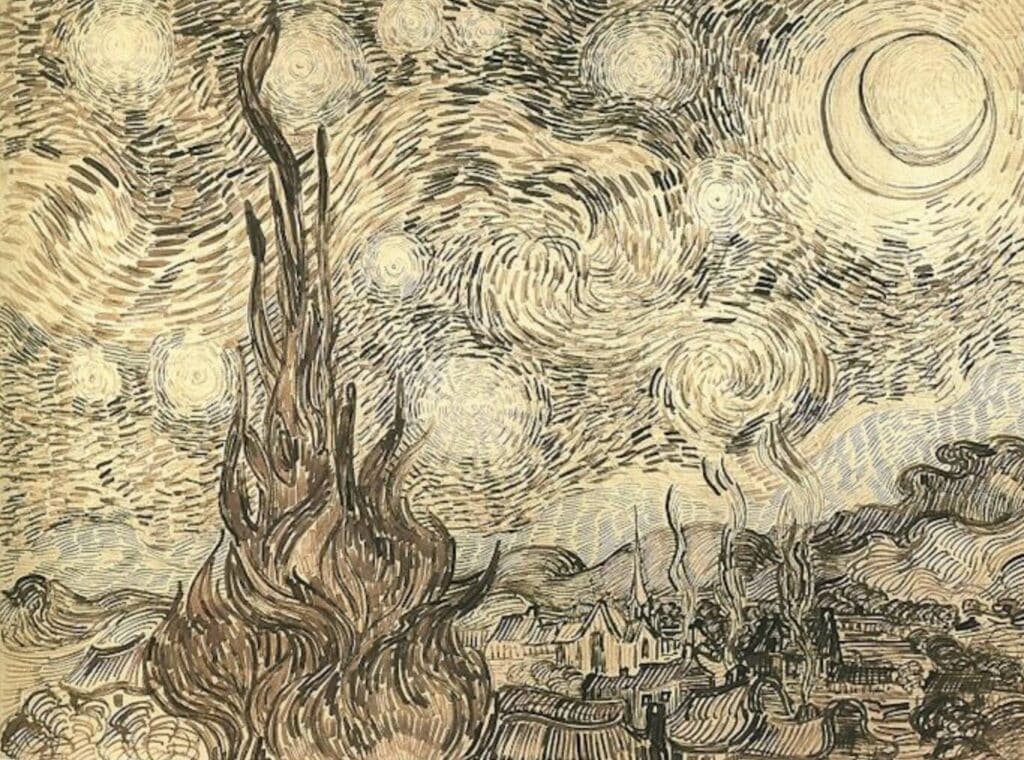
The drawings from this period are remarkable for their innovative use of line to convey movement and emotion. This technique would reach its zenith in his iconic paintings such as “Starry Night.” The lines in these drawings are more than mere contours; they pulsate with energy, enhancing the emotional resonance of the subjects, whether it be the tranquil beauty of the Provençal landscape or the inner turmoil mirrored in Van Gogh’s self-portraits.
This evolving mastery of line and color was aesthetic and deeply reflective of Van Gogh’s struggles and his relentless quest for emotional and spiritual salvation through art. Each stroke, whether on canvas or paper, was a testament to his belief in the expressive power of art, a belief that sustained him through his darkest hours.
In the final months of his life, Van Gogh’s drawings reveal an artist at the height of his powers, unafraid to explore the depths of human suffering and ecstasy. His lines, more confident and expressive than ever, are charged with an urgency and intensity that seem to foresee his impending demise. These late works are a poignant reminder of Van Gogh’s enduring legacy as an artist who transformed personal adversity into profound artistic triumph.
As we trace the arc of Van Gogh’s drawing style from the meticulous draftsman to the impassioned visionary, we witness not just the evolution of an artist but the metamorphosis of art itself. Through his fearless experimentation and unwavering commitment to expressing his inner world, Van Gogh forever altered the landscape of art, challenging us to see the world anew through the vibrant lens of his extraordinary vision.
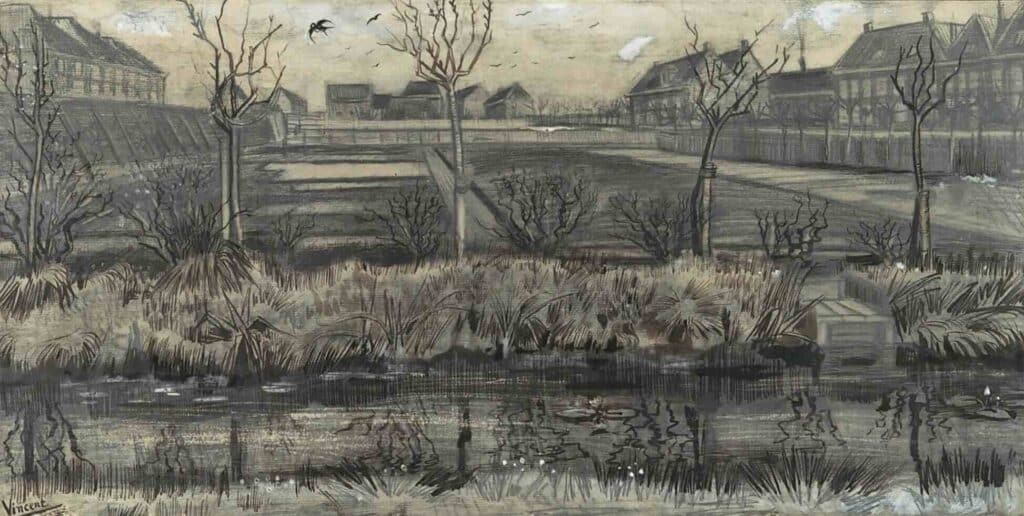
Techniques and Materials
Venturing further into the exploration of Vincent van Gogh’s drawings, it’s crucial to dissect the physical components of his craft—namely, the techniques and materials that allowed his emotive vision to take hold on paper. As Van Gogh’s journey through art was anything but static, his materials and methods evolved, offering us a deeper understanding of how this evolution paralleled his artistic and emotional transformations.
Van Gogh favored a variety of drawing instruments, with reed pens, graphite pencils, and charcoal being predominant in his toolkit. The reed pen, a choice that became particularly significant during his time in Arles, allowed for a dynamic range of marks. Van Gogh capitalized on this, using swift, confident strokes to build texture and depth, a technique breathed life into the swirling skies and wind-swept fields so often depicted in his work.
The organic quality of the reed pen’s line, varying in thickness and intensity with pressure and angle, mirrored the inherent variability in nature, echoing Van Gogh’s desire to capture its essence authentically.
Graphite and charcoal were staples in Van Gogh’s early work, and their darker, more somber tones complemented his initial stylistic preferences. However, as his style evolved, so did his method of employing these materials.
By combining them with other media, such as ink or watercolor, he introduced color into his drawings, a practice that paralleled his experiments with vibrant palettes in painting. This interplay of materials diversified the textures within a single piece and allowed Van Gogh to explore the effects of light and shadow in new, compelling ways.
Paper choice was another aspect where Van Gogh’s preferences could influence the outcome of his drawings. From coarse textured papers, which added a rustic, tactile feel to his work, to smoother surfaces that allowed for finer detailing, the choice of paper played a crucial role in the final appearance of his drawings.
Van Gogh was not one to shy away from unconventional materials either, sometimes opting for commercially available lined or squared papers, which added an unexpected, almost modernist grid structure to the backdrop of his sketches.
Ink, introduced more prominently during his Paris years, became a favored material for its ability to outline and fill with precision and clarity. The fluidity of ink allowed Van Gogh to experiment with varying degrees of transparency and opacity, techniques he leveraged to instill a sense of depth and volume in his compositions. His use of Japanese calligraphy brushes for ink work further attests to his innovative spirit, borrowing from other cultures to enhance his expressive capabilities.
Lastly, discussing Van Gogh’s drawing techniques without mentioning his exploratory use of color is impossible. Though less commonly associated with his drawings than his paintings, Van Gogh incorporated colored inks, chalks, and watercolors into his drawings, especially later in his career. This integration of color, though at times subtle, marked a departure from traditional drawing norms of the time and underscored Van Gogh’s pioneering approach to art.
Vincent van Gogh’s drawings, rich with intuitive lines, expressive marks, and experimental textures, tell the story of an artist relentlessly in pursuit of emotional honesty through his craft. His choice of materials and techniques facilitated this quest and propelled him toward his enduring legacy as a master of expression, whose works continue to captivate and inspire.
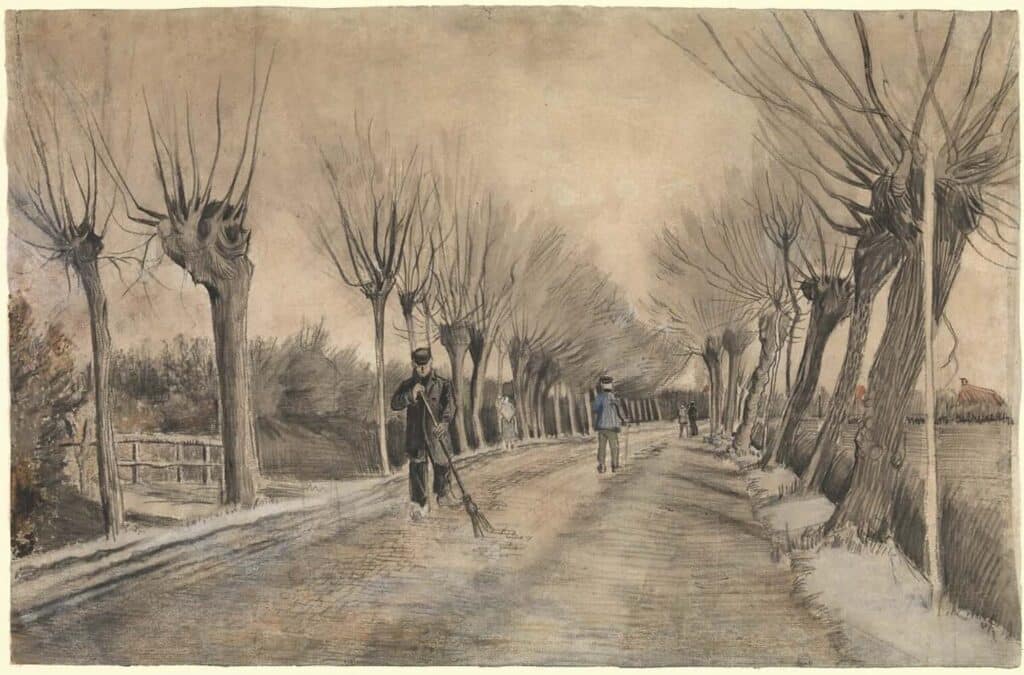
Iconic Drawings and Their Significance
Vincent Van Gogh’s journey as an artist is as complex and captivating as his paintings. However, a lesser-discussed aspect of his oeuvre is his mastery over the medium of drawing. Van Gogh’s drawings are startlingly diverse, revealing a depth of skill and emotional intensity that match his more famous painted works.
From the early sketches characterized by somber tones and a focus on the hardship of peasant life, to the vibrant, emotionally charged drawings from his later years, these works stand as a testament to an artist perpetually searching for new ways to see and represent the world around him.
One aspect of Van Gogh’s drawings that stands out is the incredible variety of drawing instruments he employed. Moving beyond just pencils, Van Gogh’s use of reed pens, graphite, charcoal, and even combinations of these with inks and watercolors allowed him an astonishing range.
This variety wasn’t just a matter of preference, but aligned with his evolving artistic vision and emotional state. For instance, the bold, confident strokes made with a reed pen in many of his Arles sketches speak of an artist finding his voice, capturing the essence of the landscape with a newfound vibrancy that paralleled his exploration of color in painting.
The technique was always in the service of expression for Van Gogh. His use of reed pens, in particular, demonstrated an innovative approach to texture and depth. Whether sketching an olive tree’s gnarled branches or a river’s serene flow, Van Gogh’s lines pulsate with energy, each confident stroke adding to a dynamic whole. This was not art for art’s sake but a desperate, passionate engagement with the world.
Combining different media, Van Gogh often introduced graphite or charcoal to his drawings, not just for their textural qualities but also to experiment with light and shadow. Adding ink or watercolor brought a new dimension to these explorations, pushing the boundaries between drawing and painting. This media blend was particularly effective in his later works, where his visions’ emotional intensity and vibrancy demanded a broader palette.
Paper choice, too, was a crucial aspect of Van Gogh’s approach to drawing. From coarse-textured papers that added an almost physical depth to his scenes to the use of unconventional materials, each choice was deliberate, significantly impacting the final appearance of his works. The texture of the paper became an integral part of the drawing, working with the chosen medium to enhance its overall effect.
One of the most striking aspects of Van Gogh’s later drawings is his use of ink, not just for outlining but for filling, playing with transparency and opacity to create layers of meaning. The introduction of colored inks, chalks, and especially watercolors allowed him to explore color in his drawings as passionately as in his paintings. This experimentation was not merely a technical exercise but was deeply tied to Van Gogh’s emotional state and his relentless pursuit of authenticity in his art.
Van Gogh’s drawings offer a window into his soul through these evolving techniques and materials. His commitment to emotional honesty is evident in every line, whether capturing the tranquil beauty of the French countryside or expressing his turmoil in more abstract works. In these drawings, we see not just the evolution of an artist’s style but the transformation of a man who saw drawing not as a secondary activity but as a fundamental part of his artistic and emotional life.
Therefore, Van Gogh’s legacy is not just in the bold strokes of his sunflowers or the swirling stars of his night skies. It is also in the delicate lines of his drawings, the textured depth of his ink studies, and the vibrant colors of his sketches. In these works, we see an artist who continuously pushed the limits of his medium, whose drawings stand as a powerful testament to his enduring quest for depth, emotion, and beauty.

Influence of Japanese Art on Van Gogh’s Drawings
In the bustling art scene of late 19th-century Paris, Vincent Van Gogh was enamored with Japanese ukiyo-e woodblock prints. This fascination was not an isolated incident but part of a larger Japonisme trend that swept through Europe, influencing various aspects of art and design. Ever the seeker of profound artistic transformation, Van Gogh was profoundly impacted by these imports, their influence permeating deeply into his drawing practices.
Upon his move to Paris in 1886, Van Gogh’s exposure to the bold simplicity and expressive potential of Japanese art catalyzed a dramatic shift in his visual language. He began collecting ukiyo-e prints, which were affordable and widely available, turning his apartment into a mini-gallery adorned with these exotic wonders. Japanese art offered Van Gogh a new lens through which to view the world, encouraging a departure from the detailed realism of European art towards a more expressive, stylized approach.
One of the most significant takeaways from Japanese art for Van Gogh was its distinctive use of line. Ukiyo-e prints are known for their clean, decisive outlines and flat areas of color, a style that Van Gogh began to emulate in his drawings.
He adopted a more confident and assertive line work, utilizing reed pens to replicate the strong, flowing lines characteristic of Japanese woodblocks. This technique allowed Van Gogh to infuse his drawings with a sense of vitality and movement that was previously absent.
Color, too, became a central component of Van Gogh’s drawings, inspired by the vibrant palettes of Japanese prints. While traditional European art leaned towards a more subdued color scheme, the bold hues in Japanese woodblocks encouraged Van Gogh to experiment with color in unprecedented ways.
He started integrating colored inks, chalks, and watercolors into his drawings to depict the physical world and express emotional resonance and atmospheric mood. The influence of Japanese art propelled Van Gogh towards his synthesis of color, line, and form to achieve a heightened sense of expression.
Compositionally, Van Gogh drew inspiration from the’ asymmetry and flat spatial planes of Japanese prints. Moving away from traditional European perspectives, he began experimenting with unconventional compositional structures, often framing his scenes with an eye towards simplicity and focusing attention on the essential elements of the subject. This shift mirrored the Japanese aesthetic of finding beauty in the everyday, leading Van Gogh to explore novel and dynamic ways to depict landscapes, still lifes, and portraits.
Japanese art also taught Van Gogh the value of negative space, which he leveraged to create more compelling and focused compositions. In his drawings, Van Gogh started to balance detailed elements with space areas, much like the Japanese artists who utilized ma (the concept of space or gap) to invoke a sense of serenity and contemplation. This understanding allowed Van Gogh to emphasize the emotional content of his work, letting the subjects breathe and imbuing them with a sense of life.
Van Gogh’s engagement with Japanese art was not merely an aesthetic dalliance but a deep, transformative journey that reshaped his artistic vision. The lessons he absorbed from ukiyo-e prints—bold line work, vibrant coloration, compositional innovation, and the expressive potential of negative space—were instrumental in his evolution as an artist.
Through his drawing practices, Van Gogh synthesized these influences into a unique style that pushed the boundaries of Western art. This demonstrates the profound impact that cross-cultural exchange can have on creative expression. Van Gogh’s work’s fusion of Dutch intensity and Japanese elegance is a testament to the universal language of art, transcending geographic and cultural barriers to touch the soul.
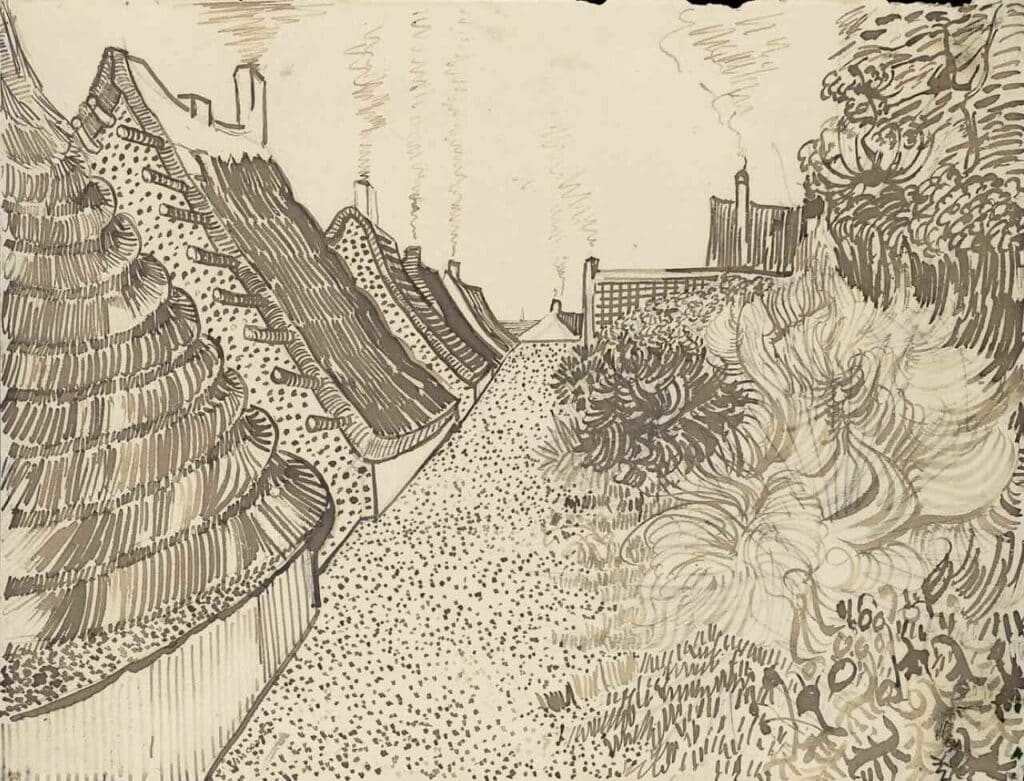
Van Gogh’s Drawings: A Window into His Mental Health
Now, let’s dive deeper into Vincent van Gogh’s artistic journey, focusing on his mental health as revealed through his drawings. It is often said that an artist’s work is a window to their soul. Through his prolific body of work, van Gogh communicated volumes not just about his external world, but also his internal struggles.
Van Gogh’s move to Paris marked a pivotal shift in his artistic style, which was heavily influenced by the Impressionism and Neo-Impressionism movements. This period was characterized by experimentation with light, color, and technique. However, beneath these vibrant Parisian scenes lay a man wrestling with his inner demons. The sporadic and often forceful application of strokes in some drawings from this era hinted at van Gogh’s underlying mental turmoil.
In Arles and Saint-Rémy, van Gogh’s drawings became more than mere representations of the world around him; they became expressions of his psychological state. The swirling skies, the twisted shapes of trees, and the intense energy of his drawings from this period speak volumes about van Gogh’s mental health. His choice of swirling lines and dramatic contrasts between light and dark is thought to mirror his fluctuating moods and intense emotions.
Van Gogh’s use of materials also mirrored his mental state. His shift to using reed pens, graphite pencils, and charcoal alongside other mediums like watercolor and ink allowed him a broader pallet for expression. These drawing instruments, coupled with his bold and innovative techniques, facilitated a raw and direct transmission of emotion. His use of these materials wasn’t merely a stylistic preference but a necessity for manifesting his emotional and psychological states onto paper.
Additionally, the evolution in van Gogh’s use of color, especially in his drawings, reveals much about his psychological journey. The incorporation of colored inks, chalks, and watercolors, particularly in the later stages of his career, reflects a continued struggle for serenity and vibrancy amidst his tumultuous emotional landscape. His drawings from this period, rich in color and dynamic in composition, underscore a relentless pursuit of emotional honesty and authenticity.
The varied textures and depths achieved through confident reed pen strokes or the combination of graphite and charcoal with watercolors suggest an exploration of artistic techniques and an attempt to grasp and convey the complexities of his mental state. This is particularly evident in van Gogh’s later works, where his mastery over these materials and techniques culminates in drawings that are at once poignant and deeply expressive.
Moreover, van Gogh’s choice of paper played a subtle yet significant role in his artistic expression. The use of coarse-textured papers or unconventional materials added another layer of depth to his drawings, further enriching his visual language of emotional honesty.
Vincent van Gogh’s drawings offer a compelling glimpse into his psyche. His work’s diversity and emotional intensity, innovative use of drawing instruments, and blending of different media all testify to his enduring quest for depth and authenticity in art and life.
Through his drawings, van Gogh laid bare his soul, offering us an unfiltered look at the profound impact of his mental health on his artistic journey. These works stand as a powerful reminder of van Gogh’s legacy as a master of expression, whose commitment to portraying emotional honesty through art continues to resonate and inspire.
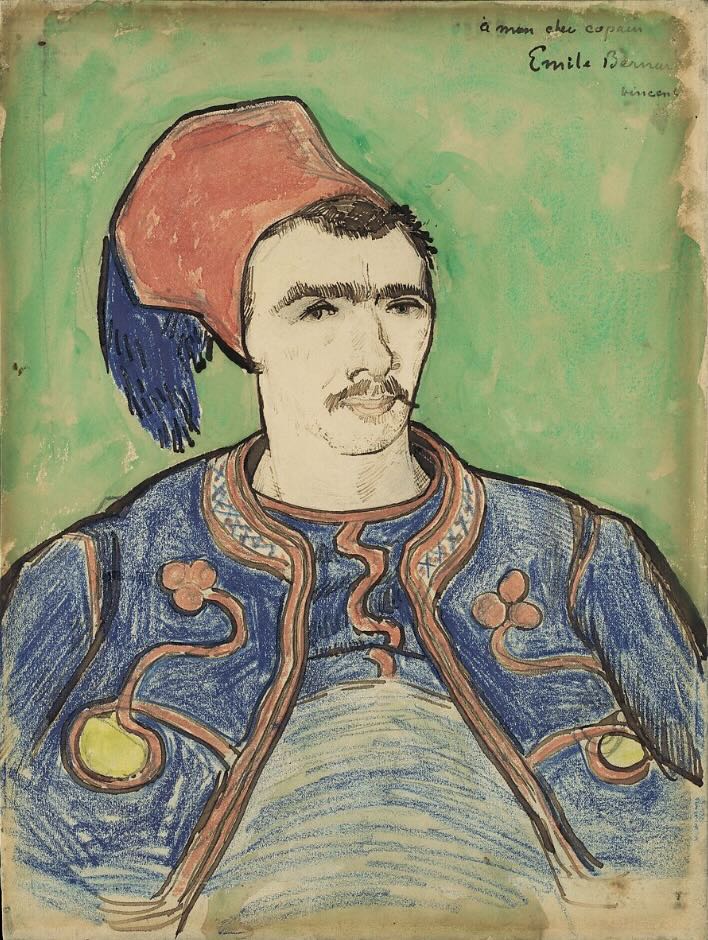
The narrative of Vincent van Gogh’s drawings unfurls a rich tapestry of an artist’s unwavering quest for self-expression and authenticity. Through the evolution of his style and choice of materials, Van Gogh invites us into his world, where each line, texture, and color holds the power to evoke deep emotional responses.
His drawings, a vital part of his artistic legacy, challenge us to look beyond the surface and connect with the profound human experience in every work. Van Gogh’s unyielding dedication to his craft and ability to transform personal adversity into artistic triumph continue to inspire and captivate, reminding us of the transformative power of art.
Anita Louise Art is dedicated to art education, great artists, and inspiring others to find and create their art. We love art that uplifts and inspires. #ArtToMakeYouSmile! #ArtToMakeYouHappy!
If you want to see any of my art, you can find out more by clicking here. If you are interested in what inspires me and my paintings, you can discover more by clicking here.
We have a free newsletter and would love you to be part of our community; you can subscribe to the newsletter by clicking here. If you have any questions, I would be happy to talk to you anytime. You can reach me, Anita, by clicking here.
Subscribe to our Anita Louise Art YouTube Channel with great videos and information by clicking here.
Join us for our podcast “5 Minutes With Art.” Spend just 5 minutes a week with us to discover and learn about great art and artists. You can find out more about our podcast by clicking here.
Related Questions
How Much Is Van Gogh’s Starry Night Worth, And Other Facts
Vincent van Gogh’s Starry Night painting is considered priceless; many have estimated that the artwork is worth over 100 million US dollars. The Museum of Modern Art in New York City has had the painting in its collection since 1941.
By clicking here, you can discover more by reading How Much Is Van Gogh’s Starry Night Worth, And Other Facts
What Was The Impact Of Vincent Van Gogh On The Art World?
Van Gogh used color, form, and emotions in his art. He had a bright palette that was individualized for his time. Even though he did not see a lot of success during his life after he died, the impact of his art can be seen in both the Expressionism and Fauvism movements that were taking place in Europe.
By clicking here, you can learn more by reading What Was The Impact Of Vincent Van Gogh On The Art World?
Why Is Van Gogh Considered Such a Great Artist?
Vincent Van Gogh Starry Night painting is considered priceless; many have estimated that the price is worth well over 100 million US dollars. The Museum of Modern Art in New York City has had the painting in its collection since 1941.
By clicking here, you can discover more by reading Why Is Van Gogh Considered Such a Great Artist?

